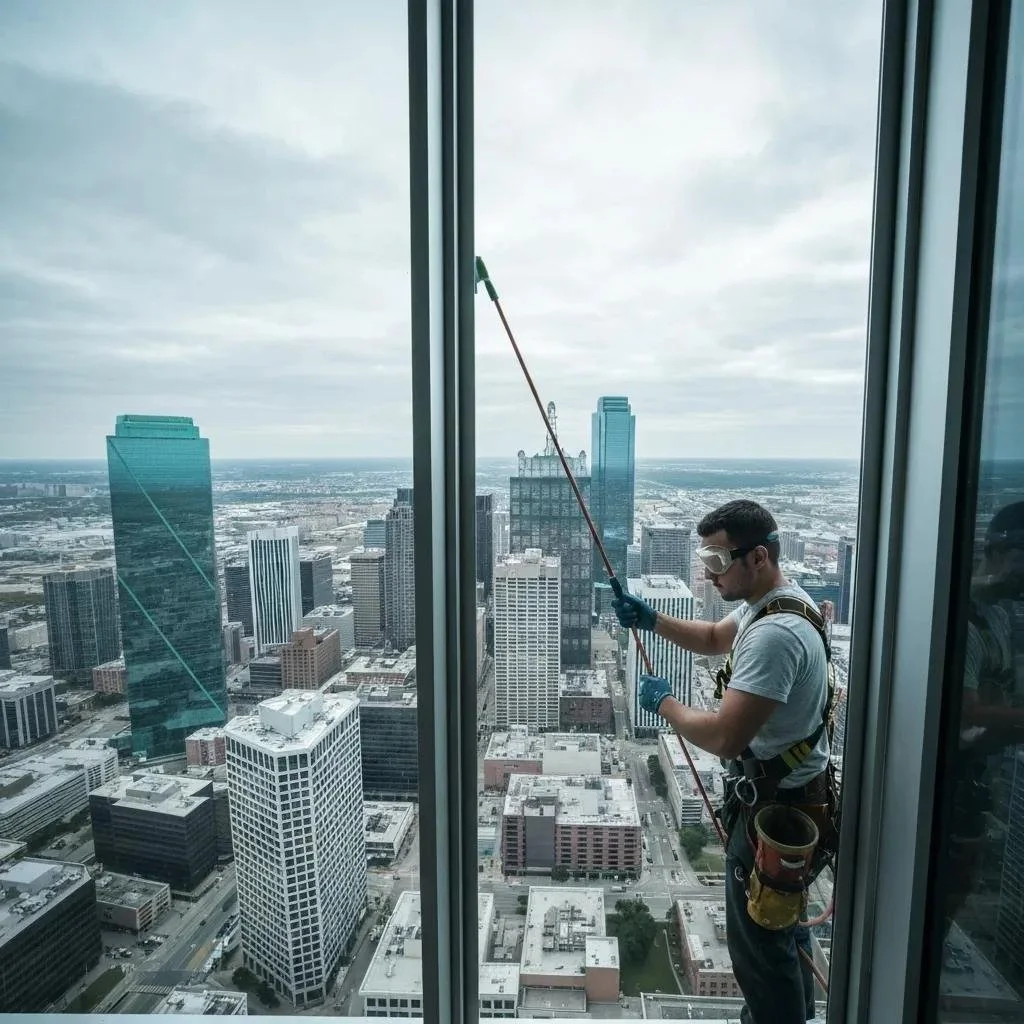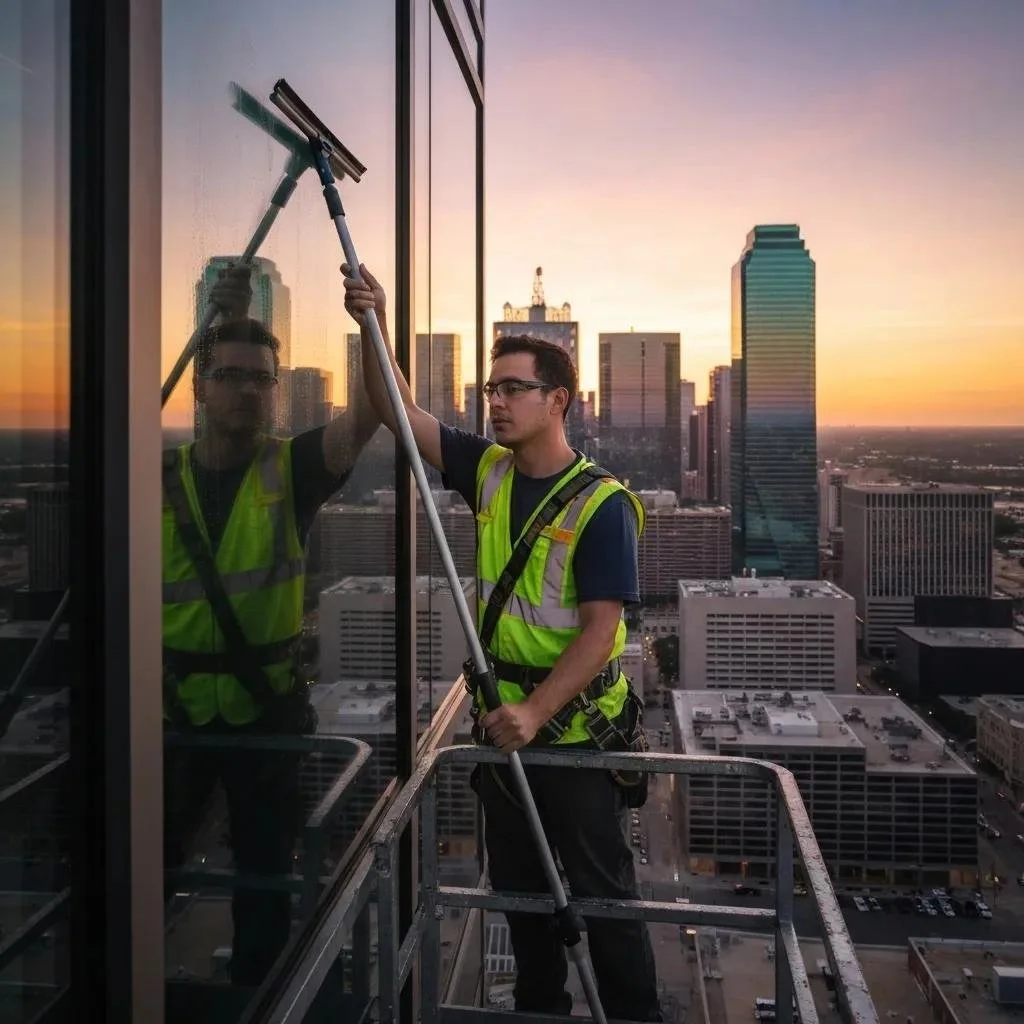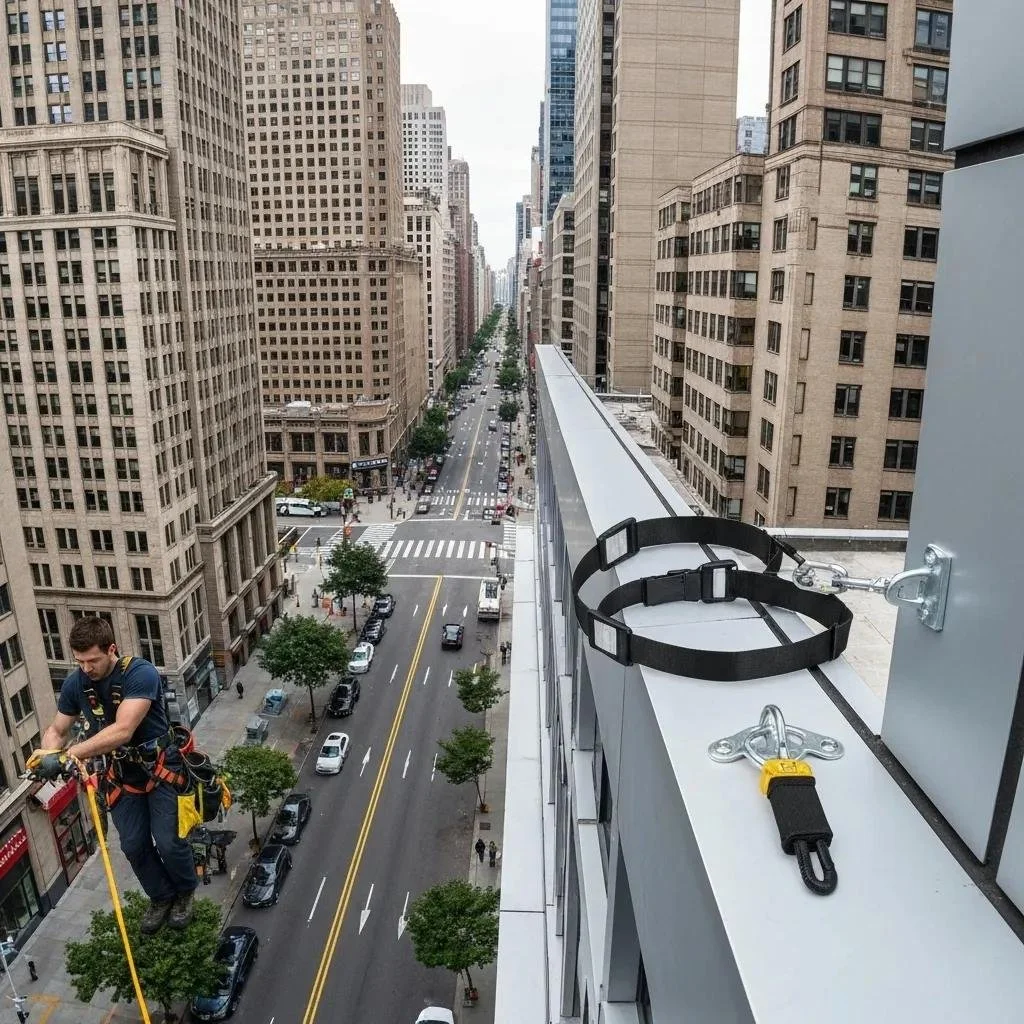Essential Window Cleaning Safety Measures to Know: Fall Prevention, PPE, and OSHA Compliance
Falls are the leading cause of serious injuries in professional window cleaning, making robust fall protection, Personal Protective Equipment (PPE), and strict adherence to OSHA standards essential for every job. In this guide on window cleaning safety, you'll discover proven fall prevention techniques, required protective gear, regulatory requirements, high-rise procedures, chemical handling safeguards, and the importance of ongoing training. Whether you're a homeowner or property manager in Dallas, these measures will help you evaluate safe practices and understand how Pegasus Window Washing – Dallas Window Cleaning Services integrates them into every project to deliver reliable, accident-free results.
What Are the Most Important Fall Protection Techniques for Window Cleaning?
Fall protection refers to the combination of equipment and procedures designed to prevent window washers from falling and to arrest a fall if one occurs, which improves overall safety and reduces accident-related costs. Broadly, these techniques include personal fall arrest systems, ladder safety practices, rope access methods, and company-specific protocols that ensure every technician works with confidence at height. Understanding each approach lays the foundation for effective risk management on residential and commercial properties alike.
Which Fall Arrest Systems Are Essential for Window Washers?
Window washers rely on personal fall arrest systems that consist of three elements: a full-body harness that distributes force, a shock-absorbing lanyard or self-retracting lifeline that limits fall distance, and a secure anchor point rated for at least 5,000 lbs.
Full-body harnesses adjust to fit each technician's torso and thighs, ensuring force from a fall is spread over strong parts of the body.
Shock-absorbing lanyards reduce the peak arresting force to under 1,800 lbs, minimizing injury risk.
Anchor points include roof anchors, structural beams, or certified permanent fixtures tested to OSHA requirements.
These systems prevent serious injuries by immediately stopping a fall, and proper inspection of each component before use reinforces reliability. Next, safe ladder practices further reduce the chances of accidents on lower elevations.
How Do Ladder Safety Practices Prevent Window Cleaning Accidents?
Safe ladder use combines correct selection, stable setup, and diligent inspection to minimize slip and tip hazards.
Choose an extension ladder rated for at least 300 lbs load capacity and inspect it for bent rails, damaged rungs, and loose fittings.
Position the ladder at a 4:1 ratio (one foot of base away from the wall for every four feet of vertical height) and secure its feet on level ground or use stabilizing devices.
Tie off the top of the ladder to a solid structure or use ladder stabilizers to prevent movement.
By following these practices, window washers maintain a steady platform for cleaning and reduce unintentional dislodgement, which complements personal fall arrest systems and keeps work areas secure.
What Are the Best Practices for Rope Access and Suspended Platform Safety?
Rope access and suspended platforms allow safe cleaning of high-rise façades when properly managed through controlled descent and mechanical advantage systems. Essential steps include:
Conducting a pre-job rope strength test and verifying splice integrity.
Using dual rope systems—one load line and one safety backup—to ensure redundancy.
Maintaining constant communication with a ground-based safety partner.
These methods permit precise positioning without the vibration of powered lifts and, when executed correctly, protect technicians from unexpected drops. Integrating rope access extends safe coverage to the tallest buildings and transitions us into company-specific implementation.
How Does Pegasus Window Washing Implement Fall Protection on Dallas Jobs?
Pegasus Window Washing implements fall protection by combining industry-leading equipment with site-specific safety plans and routine audits. Each Dallas project begins with a roof-top anchor inspection, harness fitting sessions, and a written fall protection plan reviewed with property managers. Technicians perform pre-shift equipment checks and maintain detailed logs, ensuring compliance with OSHA standards while delivering transparent documentation to clients. This structured approach builds trust, promotes safety, and streamlines service delivery without compromising efficiency or quality.
What Personal Protective Equipment (PPE) Is Required for Safe Window Cleaning?
Personal Protective Equipment (PPE) encompasses the gear that shields window washers from impact, chemical exposure, and environmental hazards, ensuring injury prevention and compliance with safety regulations. Proper PPE selection and usage are crucial for reducing risks associated with flying debris, slipping surfaces, and weather conditions during cleaning tasks.
Before examining specific gear, it's helpful to compare essential items across their primary functions.
Protection GearPrimary FunctionBenefitSafety GlassesShield eyes from debris and splashesPrevent corneal abrasions and irritationChemical-Resistant GlovesProtect skin from cleaning solutionsAvoid chemical burns and dermatitisHard HatGuard against falling objectsReduce risk of head traumaNon-Slip FootwearEnhance traction on wet surfacesMinimize slip-and-fall incidents
This table underscores how each PPE component contributes to overall window cleaning safety by combining protective attributes with practical benefits. Next, we explore the details of eye and hand protection.
Which Eye and Hand Protection Gear Do Professional Window Cleaners Use?
Window cleaners wear ANSI-approved safety glasses equipped with side shields to block airborne debris and splash-resistant coatings to repel water-based solutions. Chemical-resistant nitrile or neoprene gloves provide barrier protection against detergents and alkaline cleaners while maintaining tactile sensitivity for squeegee handling. Together, these items form a frontline defense that preserves vision and skin integrity during every wash.
Why Is Head and Footwear Protection Critical for Window Washing Safety?
Hard hats rated to ANSI Z89.1 standard protect against overhead hazards such as falling hardware or branches when cleaning exterior windows. Non-slip footwear certified by OSHA 1910.136 features chemical-resistant soles and tread patterns designed to channel away liquids, reducing slip probability. By combining head and footwear protection, technicians maintain stable footing and guard against impact injuries.
How Does PPE Compliance Reduce Injury Risks in Window Cleaning?
Strict adherence to PPE requirements enforces a culture of safety and dramatically lowers injury rates. OSHA mandates regular training on gear inspection, correct donning procedures, and replacement intervals—actions that minimize equipment failure. When window washers consistently use properly maintained PPE, accidents from chemical exposure, slips, and impacts become rare events rather than everyday hazards.
How Do OSHA Regulations Shape Window Cleaning Safety Standards?
OSHA regulations establish nationwide requirements for fall protection, hazard communication, and worker training in window cleaning operations, setting minimum performance standards that all service providers must follow to ensure a safe work environment. These rules govern equipment specifications, inspection schedules, and documented procedures, forming the backbone of industry compliance.
StandardRequirementApplicability29 CFR 1910.28Fall protection for elevations of 4 ft or moreAll window cleaning tasks above 4 ft29 CFR 1910.132General requirement for PPEAll operations with exposure to hazards29 CFR 1910.66Powered platforms and suspension scaffoldsSuspended platform operations at height
These regulations mandate the use of fall arrest systems, PPE, and equipment inspections to protect window cleaners. Understanding these foundational rules paves the way for exploring training requirements and hazard communication.
What Are the Key OSHA Fall Protection Standards for Window Cleaning?
OSHA 29 CFR 1910.28 requires employers to provide guardrails, safety nets, or personal fall arrest systems when workers are exposed to falls of 4 ft or more. This standard dictates anchor strength, deceleration device performance, and rescue planning, ensuring that fall protection equipment meets precise structural and functional criteria.
How Does OSHA Mandate Training and Hazard Communication for Window Washers?
Under 29 CFR 1910.1200, employers must inform workers about chemical hazards through labels, safety data sheets (SDS), and training sessions. Additionally, 29 CFR 1910.30 requires annual fall protection training that covers equipment use, inspection, and rescue procedures. By integrating these elements, companies maintain informed crews ready to identify and mitigate on-the-job risks.
How Can Dallas Window Cleaning Companies Ensure OSHA Compliance?
Local service providers conduct regular site audits, maintain equipment inspection logs, and hold quarterly refresher sessions to align with OSHA updates. By partnering with accredited training organizations and documenting every step—from harness inspection to SDS distribution—Dallas businesses demonstrate compliance and reinforce their safety commitment to property managers and homeowners.
What Are Safe Window Cleaning Techniques for High-Rise Buildings?
Safe high-rise window cleaning combines specialized harness systems, thorough risk assessments, and adaptability to weather conditions, enabling technicians to work on tall façades while minimizing exposure to fall and environmental hazards. These techniques enhance productivity and ensure that safety remains the top priority even at extreme elevations.
How Are Safety Harnesses and Anchor Points Used in High-Rise Window Cleaning?
Technicians use double-lanyard harnesses attached to both static and movable anchor points, allowing secure transition between positions without ever disconnecting completely. Anchor points include rooftop lifelines, overhead beam clamps, and certified davit arms that comply with ANSI Z359 standards. This redundancy prevents accidental detachment and ensures continuous protection throughout the cleaning process.
What Risk Assessments Are Necessary Before High-Rise Window Cleaning?
Before any operation, a risk assessment identifies structural load capacities, evaluates anchor installation sites, and reviews emergency rescue procedures.
Assessment FactorConsiderationOutcomeStructural IntegrityRoof and façade support ratingsVerified safe anchor locationsEnvironmental HazardsNearby power lines or falling debris zonesAdjusted work area boundariesRescue AccessibilityAccess routes for emergency respondersClear evacuation and retrieval plan
A thorough risk assessment ensures every potential hazard is identified and mitigated before technicians ascend, creating a safer work environment.
How Does Weather Impact Safety During Outdoor High-Rise Window Cleaning?
Wind speeds over 25 mph increase pendulum swing risk, while rain and ice reduce anchor stability and ladder traction. Monitoring forecasts and pausing work during hazardous conditions prevents accidents and protects both workers and property. Adapting schedules based on real-time weather data maintains safety without sacrificing service quality.
How Should Window Cleaning Chemicals Be Handled Safely?
Safe chemical handling involves selecting the proper cleaning solutions, using spill-prevention techniques, and providing adequate ventilation to minimize inhalation and skin contact. By establishing clear protocols for dilution, application, and disposal, window cleaning teams prevent harmful exposures and maintain a healthy work environment.
What Are the Best Practices for Safe Handling of Cleaning Solutions?
Before applying any solution, review the Safety Data Sheet (SDS) for hazard information and recommended first-aid measures.
Dilute concentrates in a well-ventilated area wearing chemical-resistant gloves and eye protection.
Store solutions in clearly labeled, sealed containers to prevent cross-contamination.
Use drip trays and secondary containment to catch spills and avoid surface damage.
Adhering to these steps prevents chemical burns, inhalation injuries, and property harm, reinforcing overall window cleaning safety.
How Do Eco-Friendly and Non-Toxic Cleaners Improve Safety?
Green cleaning agents formulated with plant-based surfactants and biodegradable ingredients reduce volatile organic compound (VOC) emissions and eliminate harsh alkalis, lowering irritation risk for both technicians and indoor occupants. By choosing non-toxic formulations, companies protect environmental health and demonstrate a commitment to sustainable safety practices.
Why Is Ongoing Training and Certification Vital for Window Cleaning Safety?
Continuous training and professional certifications reinforce safe work practices, ensure compliance with evolving regulations, and validate technician expertise, which collectively reduce accident rates and build client confidence in service quality. Regular education keeps crews prepared for new equipment, emerging hazards, and best-practice updates.
What Professional Certifications Support Window Cleaning Safety?
Certifications from industry organizations demonstrate competence and commitment:
OSHA Authorized Trainer Certification – authorizes companies to deliver in-house safety programs.
International Window Cleaning Association (IWCA) Certified Technician – validates proficiency in high-rise and rope access techniques.
OSHA 10/30-Hour Outreach – provides foundational knowledge of general industry or construction safety regulations.
These credentials signal to clients that technicians meet national safety benchmarks.
How Does Regular Safety Training Reduce Accidents?
Quarterly refresher courses on equipment inspection, fall rescue drills, and chemical hazard awareness reinforce proper procedures and correct minor deviations before they become major issues. This proactive approach fosters a safety-first culture, contributing to fewer incidents and higher service consistency.
What Emergency Procedures Should Window Cleaners Know?
Every technician must know how to perform a suspended platform rescue, administer basic first aid for chemical exposures, and communicate effectively with emergency responders. Documented rescue plans, practiced annually, ensure swift, coordinated responses when seconds count.
How Can Property Managers and Homeowners Ensure Window Cleaning Safety?
Property managers and homeowners can safeguard their buildings and tenants by verifying service providers' safety credentials, asking targeted questions, and requesting transparent documentation of protocols. This due diligence ensures that the selected window cleaning company meets the highest safety standards and minimizes liability.
What Questions Should You Ask Your Window Cleaning Service About Safety?
"Which fall protection systems and PPE do you use for my property?"
"Can you provide documentation of your OSHA training and equipment inspection logs?"
"How do you adapt procedures for high-rise versus low-rise buildings?"
Asking these inquiries demonstrates commitment to safety and clarifies expectations before work begins.
How Does Pegasus Window Washing Communicate Its Safety Commitment?
Pegasus Window Washing maintains up-to-date training records, publishes site-specific safety plans, and conducts pre-job walkthroughs with clients. Technicians present harness and ladder inspection certificates on request, and managers share risk assessments to ensure full transparency. This open approach reassures property stakeholders of professional care and accountability. If you're ready to schedule a service or request an estimate, visit Contact Pegasus Window Washing - Get a Free Estimate to connect with our team.
Where Can You Find Dallas-Specific Window Cleaning Safety Regulations?
Dallas contractors follow OSHA guidelines supplemented by Texas Department of Licensing and Regulation recommendations, local building codes, and insurance carrier standards. Consulting these local authorities and reviewing the Texas Roof Wardens Guidelines will help property managers align safety requirements with municipal rules and industry practices.
Operating at heights involves inherent risks, but applying robust fall protection, appropriate PPE, strict regulatory compliance, and continuous training transforms window cleaning into a controlled, efficient, and safe service. By partnering with a provider that prioritizes safety—documenting every step from risk assessment to emergency rescue—you ensure the well-being of technicians and the integrity of your property. Ready to experience professional window cleaning with safety at its core? Contact Pegasus Window Washing today for expert service, transparent protocols, and a free safety-focused estimate.




